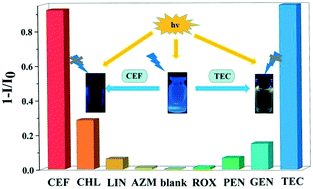Four MOFs with isomeric ligands as fluorescent probes for highly selective, sensitive and stable detection of antibiotics in water†
Abstract
The pollution and damage caused by antibiotics in water have aroused serious concern. Metal–organic frameworks (MOF), which have been hotly investigated as a novel kind of sensing materials, have been tentatively applied to the detection of antibiotics in recent years. In this work, four new Zn(II)/Cd(II) coordination polymers, [Cd(opda)(mbib)(H2O)] (1), [Cd(opda)(pbib)(H2O)] (2), [Cd(ppda)(mbib)] (3), and [Zn2(mpda)2(mbib)2]·2H2O (4), (H2opda = 1,2-phenylenediacetic acid, H2mpda = 1,3-phenylenediacetic acid, H2ppda = 1,4-phenylenediacetic acid, mbib = 1,3-bis(imidazolyl)benzene, pbib = 1,4-bis(imidazolyl)benzene), have been synthesized using bis(imidazole) and phenylenediacetate isomers under hydrothermal conditions. The flexible pda and bib ligands in 1–3 afford 2D (4,4)-connected layers, which are further stacked in an offset fashion with an ABAB sequence to propagate into a 3D supramolecular architecture through strong C–H⋯π and C–H⋯O interactions. In contrast, the flexible cis-conformation mpda and mbib ligands in 4 can be seen as “V”-type building blocks, linking Zn(II) atoms to form a 1D loop chain. The structural diversity of these complexes is mainly attributed to the different coordination modes and isomer conformations of the flexible phenylenediacetic acid and bis(imidazole) ligands. The application of the fluorescence properties of the four complexes for detecting the antibiotics cefixime (CEF) and tetracycline (TEC) and the related mechanisms have been researched. Complexes 1–4 exhibit high quenching percentages in low-concentration aqueous solutions, with values of 94.9%, 97.8%, 95.5%, and 97.2% (toward CEF) and 97.7%, 96.7%, 96.4%, and 97.4% (toward TEC), respectively. Compared with 1–3, complex 4 has a higher quenching percentage, which may be because 4 is a 3D porous supramolecular network. The detection limits of complexes 1–4 have been measured to be 0.278 μM, 0.379 μM, 0.52 μM, and 0.171 μM (for CEF) and 0.384 μM, 0.189 μM, 0.421 μM, and 0.137 μM (for TEC), which surpass/approach those of most of the reported MOF-based fluorescent sensing materials. Systematic analysis of the sensing mechanism reveals that photoinduced electron transfer and the inner filter effect contribute to the realization of the sensing process.



 Please wait while we load your content...
Please wait while we load your content...